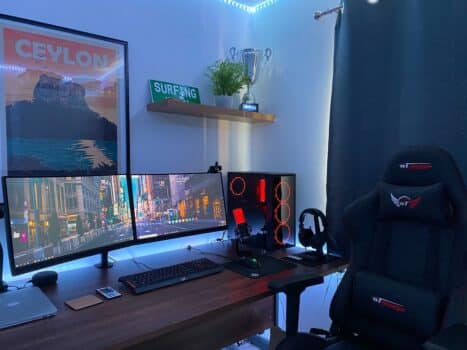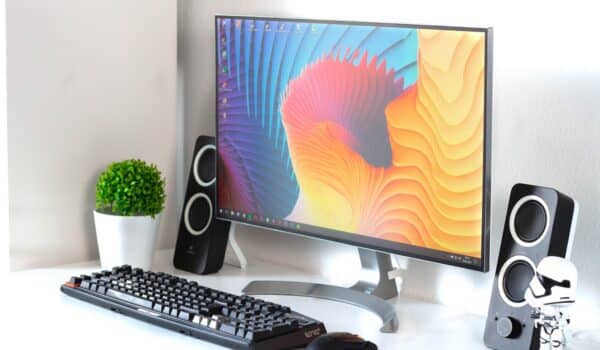The best dual monitor stand will either be desk-mounted, wall-mounted, or a free-standing unit. They present an affordable option and are highly flexible due to their multiple color choices, easy installations, and ergonomic designs.
You will find dual as well as single monitor arms on the market, which can make it tough to choose between the two. Today’s guide looks at the advantages and disadvantages of both single and dual monitor stands to choose the best model for home or office settings.
Advantages Of A Dual Monitor Arm?

The primary benefit of using dual monitor arms compared to single monitor arms is they look cleaner. Thanks to fewer wires and cables running behind the screen, dual monitor stands appear clutter-free.
This is especially pleasing for people with no trays for standing desks, which leaves them with too many wires to handle when there are multiple units on the table. And you might think that a cheaper cable management tray with a thinner design for a sit-stand desk will work, but it will still prove chaotic to handle the wires.
But if dual arms help organize the desk space better, why do people opt for two single monitor arms?
Advantages Of Two Single Arms
Most people place dual monitors on a standing desk for stability, despite the fact that the setup is much heavier. Two units weigh more than a single unit, so standing desk users must choose a suitable arm with the additional weight capacity.
However, the single arms guarantee reliability, and heavy-duty standing desks don’t lose their integrity even after regular use. All you need is to determine how to drill mounting holes for the monitor arms into the desk setup, so refer to the instructions provided by the monitor arm manufacturers.
Where To Use A Dual Monitor Stand
Although two stock monitor stands might be the ideal setup for some people, a dual monitor stand represents more freedom and functionality. It will allow you to adjust and reposition the monitors independently by attaching a stand on either side of the desktop space.
Moreover, the setup proves useful when sharing data with the person sitting next to you. The best part is that since the arms of the dual monitor stand won’t bump into each other, changing the alignment of the two monitors won’t be difficult.
What’s more, monitor arms for dual stands are lightweight while ensuring installation is pretty straightforward. We have seen people use two stands and two screens to work on one monitor while coding on another. And even gamers can use the dual setup as it makes multitasking easier.
Things To Consider Before Using Two Single-Arm Monitors
Compared to a dual monitor arm, using two single arms on the desk surface allows greater flexibility and movement to place the monitors on opposite ends of the table. But it’s important to think about –
- Extra weight
- More cable management
- Added costs
We suggest avoiding standing desks with MDF boards, as they don’t have sufficient weight capacity and may not be suitable for drilling holes. Rather, it would be best to use a deeper and wider desk for two monitors.
Other Factors To Note
Depending on your preference and computer monitors, ask the monitor manufacturers – how much is a dual monitor stand. Once you get an idea, you will see that dual monitors with adjustable arms are a valuable investment.
For one, they make cable management easier since you won’t have to install the second monitor at the other end of the table. But it’s crucial to ensure that the desk features a solid construction to not buckle under the added weight.
Moreover, if you are using the same monitors, they won’t come with independent height adjustment between the units. While the monitor height varies for different models, dual units only have a single height in most cases.

Dual Monitor Stand Vs Two Single Monitor Stands Conclusion
Choosing the right monitor arm isn’t difficult if you know what you want. From experience, we have seen that dual monitors fail to make the desired L-shape or achieve the correct tilt range. That’s why two single-stand units offer proper ergonomics for convenient positioning.
There are wall mount and VESA mount models, but most monitors use desk clamps to guarantee reliability for long-lasting performance. However, keeping the desk area clean will be more challenging, owing to the extra wires running behind the monitor.
In some cases, tables have a hole in the middle for passing the wires, but it affects the structural integrity of the platform. At the end of the day, both setups have their pros and cons, so it ultimately comes down to your preference.
And if you’ve liked reading this article, do check out our guide on how does a thermal camera work!


